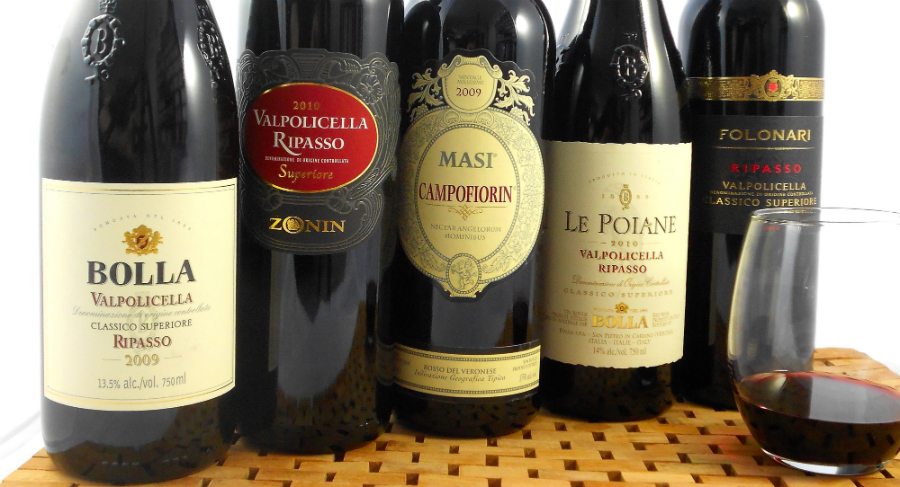God I love Amarone. Mind you everybody does. It’s got this amazing complexity, due to a combination of vinification and varietals that make the stuff irresistible. The problem with Amarone is it costs about $40 per. Call me cheap but we don’t drink that kind of wine every night.
Fortunately there is an alternative: Ripasso!
For many folks this still will not be an everyday wine. It costs between $15 and $25, which may make it a once-a-week/party wine. But if your budget runs a little richer it’s cheap enough to be an everyday dinner wine.
The wine is less intense, brighter and younger when drunk beside an Amarone, but when drunk beside any other wine, astonishingly complex. It is quite a voluptuous wine, asking only that you lay back and think happy thoughts. It also suits the New World and the modern palate.
The appeal lies in the choice of grape – primarily corvina, rondinella, and molinara. They produce a completely different finish from the French varietals. That final kick is what makes for such a brilliant food wine.
These days the most common attribute to a popular cocktail-style wine is to have no finish whatsoever. In creating the smooth, slightly sweet palate, with very tame tannins, the wine either ends sweet showing off the residual sugar, or ends vaguely. A sweet ending has consumers crying ëSweet wine!í in the same voice they would shout ëfire!í. The challenge for such wines is to be sweet and not sweet simultaneously: no mean feat.
Such wines are emulating – sort of – what happens if you age a well-made wine, letting the tannins relax and the fruit shine with no residual sugar. Ripasso is also using a clever technique to arrive at the same end, by using once-fermented pomace first used to make Amarone.
Amarone is made from partially dried grapes, almost raisins. It is the hot climate equivalent of Icewine. This low fluid, high sugar relationship creates an intesne wine with tremendous flavours. You can almost see the farmers wincing as they shovel that pomace into animal feed… There’s still goodness remaining!
Ripasso, or Appassiamento style wines take that same once used pomace and add it to already fermented young Valpolicella. The wine then ferments a second time over the pomace, the remaining sugar giving the yeast a new kick.
The pomace adds extra richness, fruitiness and smoothness to the original wine without adding hugely to the tannin load or residual sugar.
The process was apparently perfected by Masi, a firm with oh, let’s call it a “complex” relationship with the appellation authorities. The result is their ripasso which should be the region’s flagship is actually certified as an IGT wine.
IGT just means ‘typical’, a category created to allow the always inventive, and often anarchic Italian wine scene to continue to operate as it has for millennia. These are folks who when someone tries to tell them how to make wine, react like the citizens of Dog River do to the name Wullerton.
Italian politics aside Campofiorin is alone in these four in that it does not clearly state Ripasso on the front label. The wine is however the reason I drink the stuff. It’s got a slightly raisiny bouquet, with some hints of fruit and spice, and nice soft rounded palate, and a lingering cherry vanilla finish.
Folonari is the least expensive of these wines, with a bouquet of jam and cherry and a touch of mint. The palate and body are lighter than the Campofiorin with a spicier attack and a slightly sweeter finish. It is the classic blend of roughly two-thirds corvino, a quarter rondinella and the balance made of molinara, very much like the Campofiorin, but somehow a completely different wine.
Bolla has two ripasso well distributed on the prairies and they are different only in degree. As near as I can tell from the vintner descriptions the only real difference is the extra 6 months on oak for Le Poiane. The grape blend is slightly different than the other two relying more on corvinone than corvina.
Theoretically, the low yielding and ancient clone produces a denser, more perfumed wine. It’s rare enough that I am agnostic on the topic, but I must admit, Le Poiane has been my go-to ripasso for over ten years.
The bouquet is fruity with nice vanilla and spice undertones, the palate is dense, plush and velvety; and the finish, a beautiful black cherry with some mint.
The more prosaic Bolla ripasso, is very similar but noticeably less luscious. The wine is slightly more angular. Does this make it a worse wine? Not for me. Over the course of tasting these wines – I bought about half a dozen of each, just to be thorough – there were nights when I preferred the lighter wines. It’s a matter of mood, and what youíre eating as much as the wine itself.
Finally, if you’re one of those people who doubts any beverage can be worth $5 a glass, there’s Zonin Ripasso. Zonin specializes in great value wine. Their ripasso is about $16, always a great value. Compared to the others it’s a little light, but it’s still hugely more drinkable and complex than about 98% of other wines at this price point. Expect spice and jam and flavours with just that last lingering touch of almond.
The real truth is, if you see ‘ripasso’ written anywhere on the label you should buy the wine. There are dozens to be found I haven’t reviewed here. You’ll love them.
Folonari Ripasso, Italy, 2010. $17 ****
Zonin Ripasso, Italy, 2010. $16 ****
Bolla Ripasso, Italy, 2009. $19 *****
Le Poiane, Bolla, Ripasso, Italy, 2010. $22 *****
Campofiorin, Masi, Ripasso, Italy, 2010. $22.99 *****
___
James Romanow writes about Wine and all things Boozy for the Spectator Tribune. Follow him @drbooze
Follow us: @SpectatorTrib
